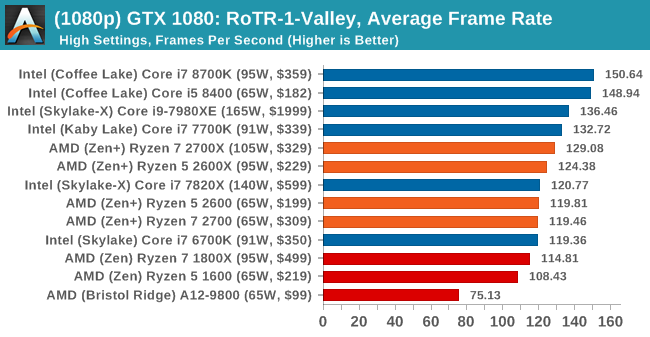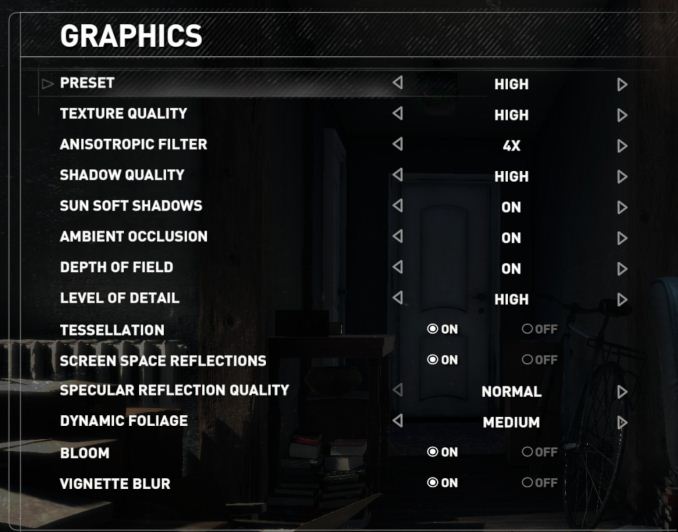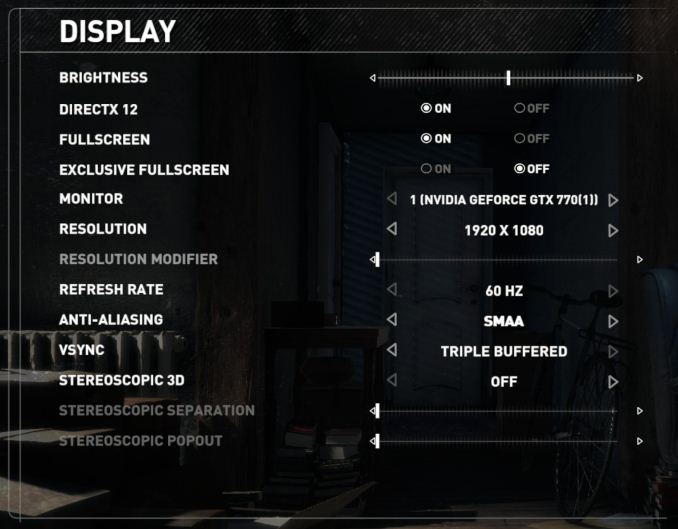The AMD 2nd Gen Ryzen Deep Dive: The 2700X, 2700, 2600X, and 2600 Tested
by Ian Cutress on April 19, 2018 9:00 AM ESTRise of the Tomb Raider
One of the newest games in the gaming benchmark suite is Rise of the Tomb Raider (RoTR), developed by Crystal Dynamics, and the sequel to the popular Tomb Raider which was loved for its automated benchmark mode. But don’t let that fool you: the benchmark mode in RoTR is very much different this time around.
Visually, the previous Tomb Raider pushed realism to the limits with features such as TressFX, and the new RoTR goes one stage further when it comes to graphics fidelity. This leads to an interesting set of requirements in hardware: some sections of the game are typically GPU limited, whereas others with a lot of long-range physics can be CPU limited, depending on how the driver can translate the DirectX 12 workload.
Where the old game had one benchmark scene, the new game has three different scenes with different requirements: Geothermal Valley (1-Valley), Prophet’s Tomb (2-Prophet) and Spine of the Mountain (3-Mountain) - and we test all three. These are three scenes designed to be taken from the game, but it has been noted that scenes like 2-Prophet shown in the benchmark can be the most CPU limited elements of that entire level, and the scene shown is only a small portion of that level. Because of this, we report the results for each scene on each graphics card separately.
Graphics options for RoTR are similar to other games in this type, offering some presets or allowing the user to configure texture quality, anisotropic filter levels, shadow quality, soft shadows, occlusion, depth of field, tessellation, reflections, foliage, bloom, and features like PureHair which updates on TressFX in the previous game.
Again, we test at 1920x1080 and 4K using our native 4K displays. At 1080p we run the High preset, while at 4K we use the Medium preset which still takes a sizable hit in frame rate.
It is worth noting that RoTR is a little different to our other benchmarks in that it keeps its graphics settings in the registry rather than a standard ini file, and unlike the previous TR game the benchmark cannot be called from the command-line. Nonetheless we scripted around these issues to automate the benchmark four times and parse the results. From the frame time data, we report the averages, 99th percentiles, and our time under analysis.
All of our benchmark results can also be found in our benchmark engine, Bench.
1080p



4K

















545 Comments
View All Comments
danjw - Friday, April 20, 2018 - link
They Anandtech used the rated speeds that the processors were stated to support by the manufactures. Anandtech, is using everything at stock. Anandtech ran all the processors through fully patched systems (both bios and OS). Not every website other tests to these same methodology. So, there will be differences in their results. None the less, Anandtech, is auditing their results to double check them. I really don't think they are going to see anything wrong. Toms, ran their Intel parts without the latest bios updates. Others overclocked their systems.Most users do not overclock their systems. Sure, a lot of us readers do, but not everyone. I overclock my systems, but, my two brothers who are both just as technical as I am, do not. It is a choice some make and others do not. The majority of users do not overclock. So, Anandtech does not overclock in their most reviews. They have at times in the past and may in the future include overclocking results in reviews, but they have are always broken out the overclocking results in a separate section and/or labeled the overclocked results to differentiate them from the standard clocked results. These are editorial choices that Anandtech makes, I don't see any problem with that.
Luckz - Monday, April 23, 2018 - link
Intel for some reason have 4 memory sticks. Weird idea.werpu - Friday, April 20, 2018 - link
Well the main difference is they tested against fully meltdown and specte patched systems, which in fact is the norm, while all other reviewers simply tested against bare metal. It is known that Intel took a pretty serious hit especially with Meltdown and a more serious hit with Spectre compared to AMD which did not have meltdown at all and to a lesser degree Spectre than Intel did.I would say Anandtechs tests are spot on.
And this reflects the sad state of nowadays performance testing which seems to be done to 99.9% by incompetent idiots or fanboys (especially the youtubers are the worst)
However in extreme situations Intel again wins since the 8700k can be oced by decapping and good cooling to 5GHz while the OC capabilities of the 2700x are basically non existent. It really depends, which is better. But the performance gap is closing and in non OCed system it is not existent anymore. It will be interesting next year when AMD has moved to 7nm while Intel still will be stuck at 10nm which they currently try to pull it but not have yet managed. Then the game might be entirely reversed.
Alphasoldier - Friday, April 20, 2018 - link
Unfortunatelly, you are the only idiot and fanboy here. Pretty much everyone stated in their reviews, the system were fully patched, all cpus were reused and everything was retested, because AMD fanboys were screaming Meltdown here, Spectre there.Now, the internet is full of this garbage review, it spreads like cancer, because AMD fanboys have nothing better to do, once again they are disappointed that 6 cores from Intel outperformed 8 cores from AMD and they are now like the Liverpool fans repeating "The next year will be ours"
But at least they got some fancy RBG cooler.
Fallen Kell - Friday, April 20, 2018 - link
Alphasoldier, I've been reading the reviews, and while many have stated they have applied the software (OS) patches, very few have stated they applied both the software and BIOS patches for the Spectre variant 2. Thew few places that I have seen which have stated both the software and BIOS patches were applied all seem to be showing much more similar results as the AT article.In anycase, Ryan stated they are looking into it, and I am certain we will see an update within the next few days. And don't come saying that I am a AMD fanboi, I havn't purchased a AMD CPU since the Thunderbird (i.e. a slot A CPU).
mapesdhs - Saturday, April 21, 2018 - link
werpu, oc an 8700K to 5GHz? Makes me laugh that a 300MHz bump over a CPU's max single core turbo is even called an oc these days. Sheesh, it's a far cry from the days of SB, oc hardly seems worth bothering with now.mkaibear - Thursday, April 19, 2018 - link
It's here, it's here!Dr. Swag - Thursday, April 19, 2018 - link
What is with the gaming benchmarks? On your tests the whole ryzen 2 series is a step above everything else, but all other reviews show it between ryzen and coffee lake...fallaha56 - Thursday, April 19, 2018 - link
This is the Spectre2 patch effectNot looking great for Intel and HFR gaming
Ryan Smith - Thursday, April 19, 2018 - link
"What is with the gaming benchmarks?"We're looking into it right now. Some of these results weren't in until very recently, so we're going back and doing some additional validation and logging to see if we can get to the bottom of this.